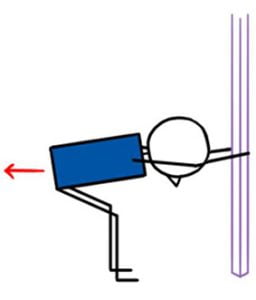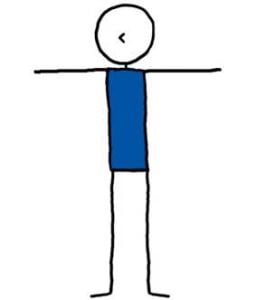
| Category: | Pilates Lesson Planner |
|---|---|
| Sub Category: | TRX |
| Types: | Balance, Hip Opener, Standing, Stretch |
| Anatomy: | Arms & Shoulders, Core, Hamstrings, Hips, Knees, Psoas |
| Chakras: | Base, Heart Centre, Sacral Centre, Solar Plexus Centre |
| Therapy: | Back Pain, Poor Posture, Sciatica |
| Drishti: | Tip Of Nose |
| Dosha: | Kapha, Pitta |
| Meridian Lines: | Stomach |
Hold onto both handles. Gaze up. Jump and squat. Repeat.
Hip opener. Strengthens thighs, buttocks, and hamstrings.
A) Sit on the front edge of a chair. B) Folded blanket under heels. C) Lift all ten toes up. D) Bring arms to tops of legs and reach outward. E) Sit back against a wall like you are in a chair. F) Add a twist. G) Sit on a block. H) Roll a blanket and place it in the crease of both knees.
Knee injury.
Click here for lots of FREE downloadable Yoga lesson plans.
Click here for lots of FREE downloadable Pilates lesson plans.
Squat Pose FAQs
What is the Sanskrit of Squat Pose?
Malasana
What are other names of Squat Pose?
- Deep squat pose
- Garland pose
- Sitting down pose
- Upavesasana
What’s the most important thing to be aware of in a Squat pose?
Make sure that the knees are pointing in the same direction as your toes.
What should I be aware of when in a Squat pose?
Squat pose challenges will challenge your entire body because it requires mobility and stability in the ankles, knees, hips, pelvis, and spine.
When in the pose silently ask yourself these questions:
- How does it feel?
- Where do I feel it?
- Are my heels lifted (the goal is to have the heels down)?
- Are my ankles rolling in?
- Are my arches collapsed?
- Are my toes turning out excessively (or do they want to)?
- How do my knees look and feel?
- Are my knees collapsing in?
- Is one knee collapsing in more than the other?
- Is one hip closer to the ground?
- Am I leaning to one side?
- Is my spine straight, arched, or rounding forward?
- Is my tailbone tucking under excessively?
If my heels are lifted when in a Squat pose what does that mean?
If your heels are lifted, it usually indicates a limitation in the Achilles tendon and calves. Allow your heels to lift and over time, with regular practice, the heels will lower down to the floor. It may also indicate hamstring tightness, piriformis tightness, or weakness in the gluteus medius. An easy way to make the pose more accessible is to place a rolled-up towel or blanket under the heels for support. If your heels are close to the ground, try widening your feet and turning the toes out.
How wide should my stance be in a Squat pose?
Have fun experimenting with a wide and narrow stance to find the ideal Squat pose width for you. There is no one-size-fits-all.
If my heels are knees collapsed when in a Squat pose what does that mean?
If your knees are collapsed (hips are internally rotated), you may have weak gluteus muscles, tight adductors (inner thighs), or a tight iliotibial band (a band of fascia along the outside of the leg from the hip to the knee).
If my low back is arched excessively when in a Squat pose what does that mean?
If your low back arched excessively, you may have tight hip flexors that are compensating for weak core muscles.
If my spine is rounded forward when in a Squat pose what does that mean?
If your spine is rounded forward, you may have weak erector spinae muscles (iliocostalis, longissimus, and spinalis), a tight thoracic (middle) spine, or tight hamstrings.
If I lean to one side when in a Squat pose what does that mean?
Leaning to one side could mean that you have a stability problem or an asymmetry (two sides that are not the same) of the ankle, knee, or hip.
If one shoulder is higher than the other in a Squat pose what does that mean?
It’s common for the shoulder of our dominant side to be tighter, and less mobile.
What are some modifications of the Squat pose?
A) Sit on the front edge of a chair.
B) Folded blanket under heels.
C) Lift all ten toes up.
D) Bring arms to tops of legs and reach outward.
E) Sit back against a wall like you are in a chair.
F) Add a twist.
G) Sit on a block.
H) Roll a blanket and place it in the crease of both knees.
TRX Suspension Training FAQs
Will TRX suspension exercises help me build lean muscle mass?
Yes. TRX suspension exercises will increase your overall strength while building lean muscle mass. The TRX is one of the most diverse pieces of equipment at your disposal because you can work out every muscle group with only your body weight. It will strengthen and define your muscles.
Are TRX workouts good for beginners?
Yes. TRX workouts are for everyone, no matter your fitness level. The amazing thing about TRX suspension training is that there are lots of modifications for every exercise. That means that it’s a perfect exercise option for beginners and experienced people.
How many TRX workouts are there?
There are hundreds of TRX exercises, and with so many progression levels, you’ll always have a fresh workout. Exercising never gets boring with the TRX. There’s always a new way to challenge yourself. For example, you can also use the cradles in different ways. You can put your hands, feet or heels in the cradles.
What are the top 10 benefits of TRX exercises?
- TRX is for beginners and advanced students.
- Exercise is fun (like a game).
- New ways to do old exercises.
- Burn loads of calories.
- Build an epic core.
- Lower risk of injury (compared with free weight training).
- Gain more muscle.
- Workout anywhere.
- Get more results in less time.
- Become a Plank master.
Am I less likely to be injured with TRX training?
Yes. TRX training research shows there is less potential for injury compared to free weight training. The reason is that TRX exercises are much easier on the joints (which are what commonly get injured during free weight training). With TRX you become more mobile, more flexible and stronger.
Can I take the TRX with me on business trips?
Yes. The TRX suspension training is mobile. When you get to your hotel, hang the TRX over a door and do your workout. If you want to go “outside”, take it to the park. There will be multiple places where you can hang the TRX.
What is the number one benefit of TRX suspension exercises?
I think it’s gotta be that you can do a workout in less time than traditional exercises. The reason is that the TRX works on strength, balance, flexibility, and core stability all at once.




 Yoga Lesson Planner
Yoga Lesson Planner
 Pilates Lesson Planner
Pilates Lesson Planner








